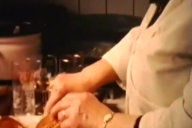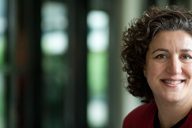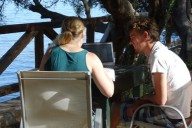 Upon entering Frank’s room at the Donders Centre at the Radboud University Nijmegen, my eyes are immediately drawn to the installation he has built, to work in a standing position, helping him to avoid RSI and stay fit. Also, I see a chair that can be transformed into a place for taking a nap during working hours. These objects are illustrative of Frank’s inventiveness to settle things his way.
Upon entering Frank’s room at the Donders Centre at the Radboud University Nijmegen, my eyes are immediately drawn to the installation he has built, to work in a standing position, helping him to avoid RSI and stay fit. Also, I see a chair that can be transformed into a place for taking a nap during working hours. These objects are illustrative of Frank’s inventiveness to settle things his way.
Frank, aged 29, achieved degrees in Artificial Intelligence, Psychology and Cognitive Neuroscience, and is now completing his PhD-thesis in the field of Neuroscience. His main research interest boils down to the question “How can we explain complex human sensorimotor behavior in simple emergent, bottom-up processes?” As a member of Artisa’s advisory committee we like to interview him about his work and his relationship to science and art.
Initially fuelled by a bet with a friend, he finished the equivalent of almost twelve years of study in less the seven years time. During his studies, he was also involved in numerous boards, among them student advisor to the dean and vice-president of the university student council. Despite these more than fulltime activities he gives the impression of having a healthy social and emotional life… We wonder where the secret of his productivity lies?
Frank explains: ‘I like almost all things I do. Moreover, I work efficiently, and I prioritize my activities. In this one year where I collected 180 credits instead of the standard 60 you wouldn’t find me at college. I’m much more productive when studying by myself. In that period I had absolute confidence in myself, so no time was wasted with procrastination. Everything I touched kind of changed into gold… Above all, I wanted to get the best out of myself, something that turned out not to be an automatic given at the university. So I went after my own challenges in extra studies, courses, and commitees.’
Sticking to his own work rhythm is another secret. Getting up early, starting the day with some jogging and meditation after which he can work for hours in a row, taking a break with a power nap and continuing again. What helps is that he likes to work alone, which makes him autonomous and gives him space to reflect.
After graduating, he knew that he easily gets bored when he can’t explore new things and be creative. The brain is a challenging subject to study as it is one of the last frontiers in science as we still know so little about it. Frank criticizes much of the research done in neuroscience as being too anthropomorphic, assuming a brain “thinks” like we humans think. In Franks view, ideally, research should be more bottom-up, letting the data define the categories.
All this encouraged him to stay at the university, to do research and write a PhD thesis. He was quite idealistic and a little naïve in wanting to alter the way we do brain research from the inside out. After a huge growth spurt he had experienced when preparing for his undergraduate studies he now slowly starts experiencing a standstill and is sometimes quite frustrated with the detailed work he has to do in brain research. He compares it with looking with a tiny straw at the brain. What would inspire him is to look at the overall picture. He is interested in questions at the intersection of Cognitive Neuroscience, Philosophy and Artificial Intelligence, like What are the Foundations of Neuroscience? However, much of doing a PhD sometimes feels like factory work to him, producing papers, rather than reflecting on the larger questions.
Artisa promotes the relationship between art and science. We wonder what Frank can tell us about this relationship both from a personal perspective as well as the perspective from neuroscience?
On a personal level Frank used to draw a lot when he was a child, a habit he lost during secondary school. During his studies, drawing came back in the form of mindmapping, which turned out to be very useful. Creating visuals is an enormous help when he is thinking and analysing.
When he started his PhD he felt the urge to do something creative in order to balance his constant thinking and ‘head’ work. He subscribed to a painting class at the Lindenberg, a cultural institution in Nijmegen, where he enjoyed the art of drawing and painting, learned many techniques and most important of all was able to “switch off his head” during this 3 hour painting class. Art gave him the much-needed relaxation. Currently, Frank is trying to strengthen the bonds between the university and the Lindenberg, to allow for relaxation and cross-fertilization.
Concerning cross-fertilization, Frank believes art and science can be regarded as two sides of the same coin: art is posing questions and science is looking for answers…They can be a source of inspiration to each other. They both start from wonderment and both have the urge to bring something new and creative. Art helps us to be curious and enter a questioning state of mind. Science on the other hand can be a source of inspiration for art and design. Frank is a great proponent of art in the university building, especially thought-provoking (science-inspired) art.
Art and science can also be each other’s study topic. For example, a question such as this might exist for readers: where is creativity located in the brain? When confronted with this question, Frank responds skeptically: ‘Neuroscience isn’t ready to provide answers about creativity. Neuroscience can locate the brain networks responsible for lifting a finger, but not yet for creative processes. These processes are very complex and involve many different connections. Actually, the problem already starts with the concept: creativity is such a higher-order, multi-level and ambiguous concept, that it is hard to define, let alone explicitly test in an experiment.’ In Frank’s opinion, cognitive neuroscience should stay away from such concepts until the lower order ‘simple’ concepts, like lifting a finger, have been given a place and have thereby informed us about the best way to ‘speak the brain’s language’. And that is already difficult enough!
The other way around, the brain as a topic of art has impressed Frank lately. For example a theatre performance inspired by the science of mirror-neurons. Mirror neurons are neurons that respond for both the execution of an action (e.g., the neuron is active for executing a hand movement) and perceiving someone else execute the movement and has been implicated in a range of phenomena – including empathy. He went three times to the performance. The first time he didn’t get it as he was mainly analyzing how the choreographer had explicitly worked with the concept of mirror-neurons. The second time, as he allowed himself to feel and experience, he got it and was thrilled. In this case, the cross-fertilization is really explicit: a cooperation is underway between the choreographer and colleague scientists from the Donders Institute to study dancers in the scanner. Frank himself, though not involved in that study, is constructing a piece of brain-inspired 3D art, to be complete at his PhD defense, which he hopes will be thought-provoking too.
Lastly, there is something universities can learn from art. Science is, like art, a fundamentally creative enterprise. Creativity is promoted by a safe environment which supports self-development and exploration; that stimulates things you like to do instead of must do…Creativity is killed by the contemporary climate of production and too many ‘must do’s’ at universities. That is why it is so important that places like Artisa exist, where you can take distance, relax, reflect, and see the greater picture. Taking such distance brings back the joy into science, which is easy to forget in the current climate. Moreover, relaxation and joy foster creativity, as has been repeatedly shown in non-brain science.
Given his experiences during his PhD, what will be the next step in Frank’s life?
‘I realized during my PhD that I thrive best in an environment where I am challenged to accomplish the maximum, where my creativity is appreciated, and I can work independently. Some of these factors were fulfilled in my PhD, others weren’t. My next step will be to start my own company in intelligent, brain-inspired, computer assisted learning. Regrettably, I can’t share the exact ideas, as early negotiations are underway with the university to possibly start a joint research-business project. I really can’t wait to get started, but first I have a PhD to finish.’
To every PhD student he would like to say: ‘keep your authenticity, curiosity, and creativity; keep having confidence in yourself, your ideas, and convictions – even when the scientific context seems to expect the opposite of you.’
‘In order to do that it helps to take distance, at a regular basis, from your research and the research context. There are many ways you can take distance. Going to a place like Artisa is one of them and, from my own experience, one that is very effective and pleasurable.’
February 2014, Celeste Neelen












